Retrospective - Five Decades
1960s
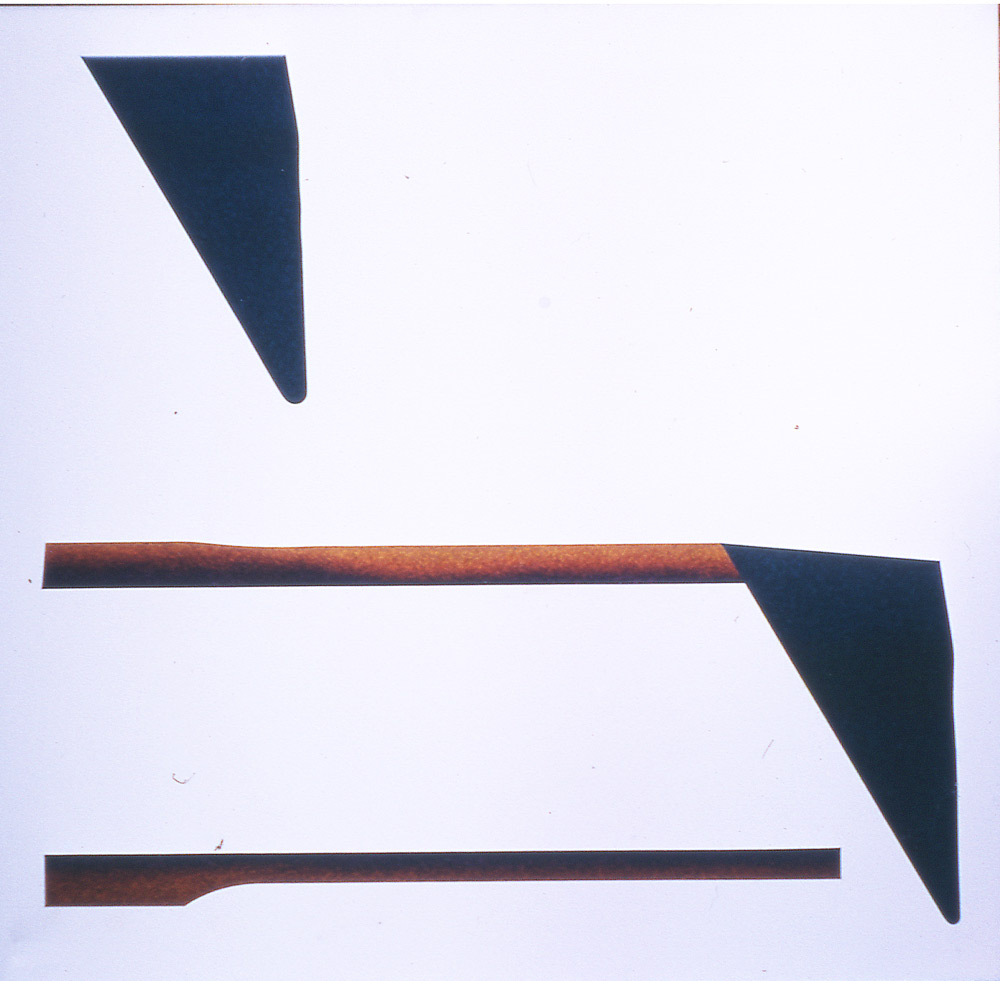
When I left the RCA in 1961 I was open to a wide range of influences - German expressionism, Picasso, and marginally by the burgeoning presence of 'Pop Art'. However I was becoming increasingly interested in abstraction. An exhibition of Kandinsky's expressionist abstract work at the Tate excited and impressed me. I was also becoming interested in the work of the Russian Constructivists, particularly El Lissitzky, and Malevitch’s suprematist works. At the same time I was intensely aware of revelatory exhibitions at the Whitechapel, of American abstract painters, Morris Louis, Jules Olitsky, Larry Poons, and also the new work of British painters, Bernard and Harold Cohen, John Hoyland etc. It was a time when finding one's own path through a mass of demanding visual and theoretical input was both exhilarating, and needed a clarity of thought in response. Issues involved in my part-time teaching at Derby College of Art in the early sixties were significant to me, connected with 'Basic Design', and Bauhaus theories of the unity of visual art and design, with particular reference to Paul Klee's amazing book, 'The Thinking Eye'.
The painting FOUR is a later addition to a series started in 1967. A number of pieces in this series were shown in Survey '67, at the Camden Arts Centre. I used this statement in the Catalogue – "I am aiming to establish a reality which will exist independently from myself. My intention is to make a vital tension between forms, to induce speculation, to create a relationship which is a synthesis between the formal and the unpredictable. Any references in my work are oblique and are references to mood." The deliberately precise relationship between the painted forms and the edges of the canvas was based on the Fibonacci Series, the mathematical ratios which made a link between a structural system and natural form. 'FOUR' was on the cusp of a move, where I started to explore painted structure. In FOUR I was concerned with a spatial tension between figure and ground to create an ambiguity and uncertainty - an abstraction not rigorously formal, but having an element of disquiet.
1970s
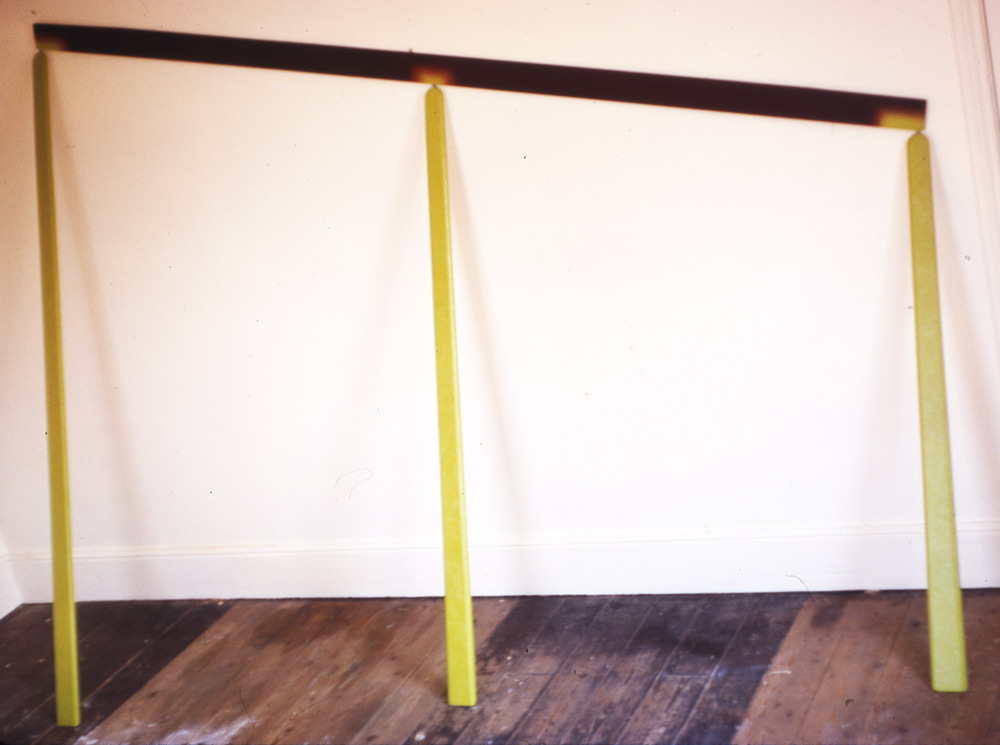
Four Connected Pieces is one of a number works where I was exploring aspects of painting linked with physical space, yet not defined as sculpture. This idea was to some degree influenced by De Stijl, and Mondrian's interest in the idea of the 'abstract interior'. A recent visit to an exhibition about De Stijl, in Eindhoven, has reawakened that interest, although the idea of a whole work interacting with a complete space has been an unresolved issue that still interests me. The series of wall/floor related pieces use conditions of balance – imbalance, inflection, change into movement and energy - works which link painting, colour and physical structure. I was then preoccupied with that synthesis, of painting, sculpture, colour and space. Works by Anthony Caro, Phillip King, etc, evoked these sensations, particularly a sculpture by Caro, shown in the Kasmin Gallery, a horizontal yellow painted piece that filled the gallery space.
Four Connected Pieces makes a spatial non-rigid connection of wall to floor. The handling is controlled/painterly with a colour emphasis on the connecting areas. It was shown in the Serpentine Gallery in 1972, 'Fourth Exhibition – Second season of seven exhibitions' – 5 artists. The whole range of the work I showed there was about constructed painting interacting in space/location. This included floor pieces that were extendable, and some of which included illumination.
The period when this work was made, from the late sixties onwards, was one of intense theoretical debate, with issues of minimalism, social/political involvement, and questions about the relevance of traditional media – painting, sculpture etc. Decisions about the direction of working practice had to be made. In work following the show more organic elements began to evolve, making more distinct connections with what have always been underlying concerns of mine.
1980s
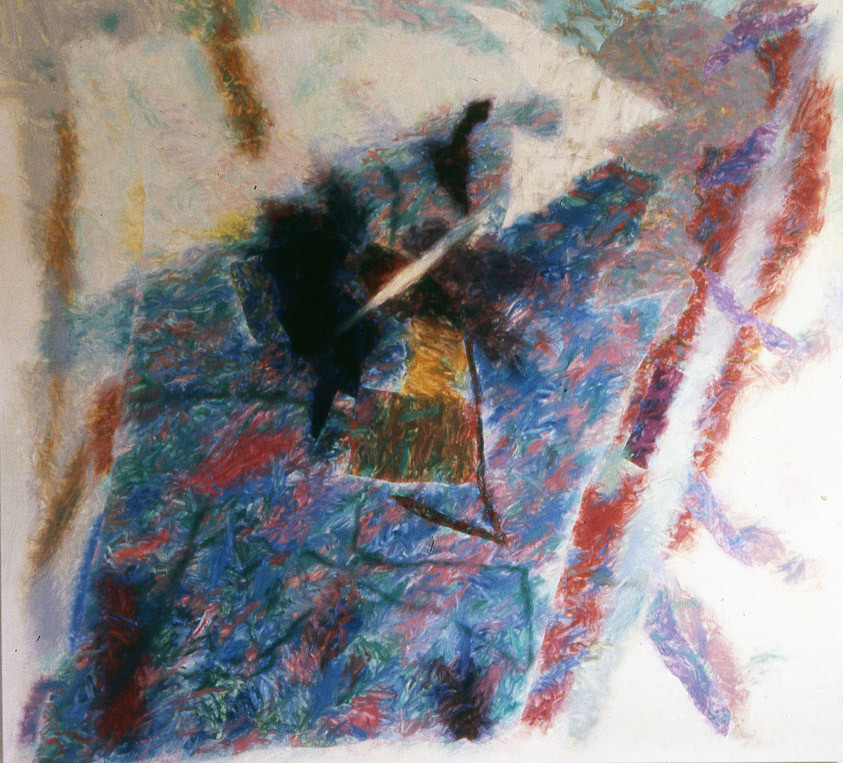
The problematic relationship between abstraction and observation, often described as an English condition/obsession, has been a long-term issue with my work. After an evolution of work making connections with nature, landscape, and light, which led to a series of exploratory shaped pieces, having sensory associations, my work in the eighties was moving towards a more fluid and open process. When looking at a work as representing a moment in time, there is necessarily no absolutely clear continuum/continuity, but a complex range of influences and input. In relation to the condition of painting at that time and its continuing relevance, I was very 'struck' by the work of Gerhard Richter, particularly the abstract paintings, the sensation of their making conveyed in their active physical presence. The paintings of the Danish artist, Per Kirkeby, also had a powerful impact of sensation and nature. A short statement from the catalogue of his exhibition at The Whitechapel in 1985:
To repeat I understand my paintings as the summation of structures. A sedimentation of very thin layers. Only in extreme despair does a thick layer emerge. In principle an endless sedimentation. But it is conspicuous that the underlying structure always shines through, even when a new layer has a completely different motif and a totally different colour.
This connected with my own involvement with the layering and evolution of a painting over time, and still does.
The painting 'Morning' marked a particular point of transition. This painting has a particular drawing as its source. It is more openly painterly than earlier controlled and sharply defined forms. My drawing was becoming more active and responsive to direct experience. Having recently been reading Merleau-Ponty’s 'Phenomenology of Perception', I get some sense, in that drawing process, of having attempted to achieve what Merleau-Ponty describes as 'union of self and perceptual field'. The painting is the result of an attempt to achieve an affinity with nature through abstraction, a reaction to something seen, as atmosphere, presence. It was 'drawing' from reality – chance configurations, conditions of light/colour, shapes of things growing, that provided a constant spur - information feeding into the background of ideas that eventually became the work. One of the disturbing problems of a ‘non pure’ kind of abstraction is the 'fixing' into recognition that takes place when literal meaning is attached to marks/shapes that need to remain mysterious. In response to that I tried to keep the content formal and obliquely allusive.
1990s
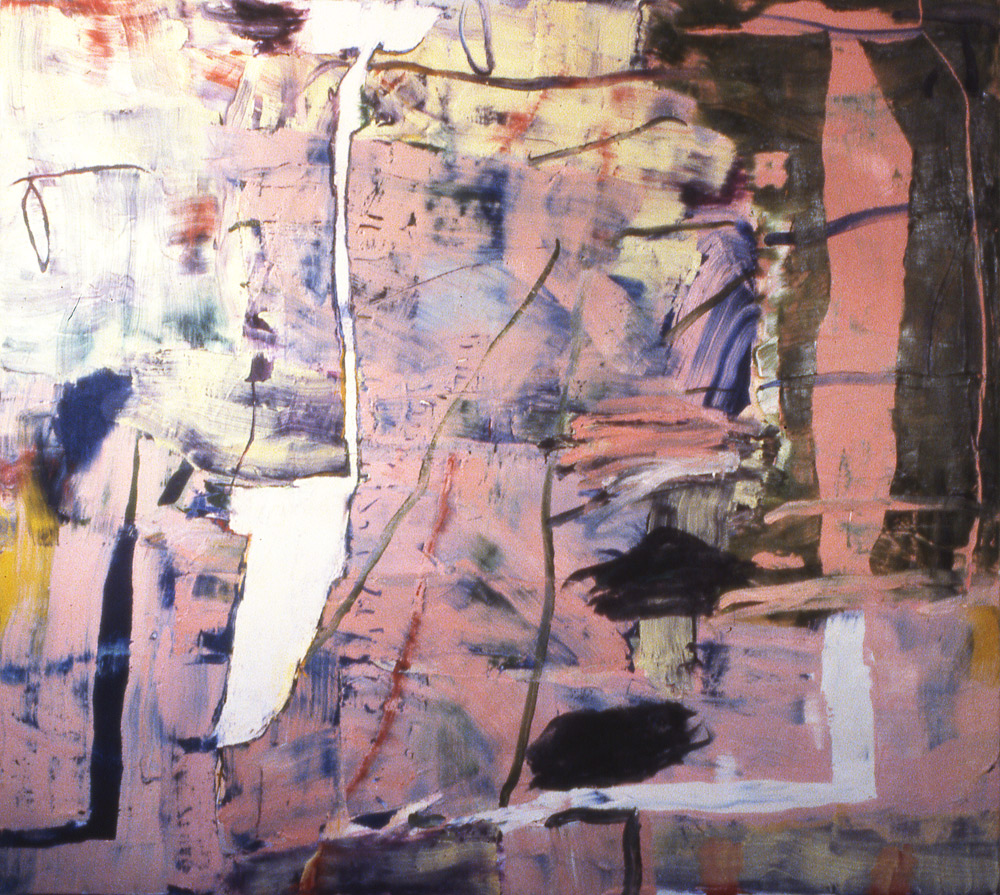
I stopped lecturing in 1996, and Two Pinks, was painted at a time when I was able to work with greater intensity and focus, although I missed the dialogue with students. The question of issues of meaning and abstraction preoccupied me. Amongst many exhibitions around that time, two shows stick in my mind – Robert Ryman at The Tate, and Philip Guston at the Tate Liverpool: Guston because his earlier moves, gradually shifting from painterly abstract expressionism to intense cartoon-like, yet still strongly painterly images which haunt my memory; and Ryman's 'object-paintings' - he says: "the content of abstract painting is the painting itself and the environment. It’s all that you see, all that’s involved in the painting – everything. The surface, light and structure, movement and composition – that’s it." This response to Guston and Ryman was not a question of influence, more that I was gripped by the duality of the experience.
Two Pinks was shown in a solo exhibition at The Bend in the River, Gainsborough, in 1997. It was painted using a combination of wax (beeswax) and oil paint, which would build up and generate an active density and physicality of marks and surface. Drawings in notebooks, direct responses to the insignificant, the banal, the transitory, sound, memory, acted then, and continue to act as a reservoir of images which feed into the work. The process of accumulating layers was and is a result of the work emerging from a complex series of decisions, considered or spontaneous. Drawing provided an impulse, a source – the painting would take its own form. The work then has to mutate and reconfigure until at some point I recognise a moment to stop.
Exhibition statement 1997:
I am absorbed by the strangeness of the whole process of painting, of it as an inexplicable activity, of form fighting chaos – I am also absorbed by the questions and difficulties surrounding painting as a practice at the present time. You have a blank canvas, an unmarked object; you slowly make a mark, a transformation of inert matter takes place – it is absurd . . . an object . . . a painting.
From notebook: 10 February 1997 (synesthesia):
Two pinks remembered from childhood – 1947/8? One in the kitchen at Flaxholme, gloss on the wall. Something about that colour, that memory got into the sense-memory that is evocative as the sense of smell is – even at the time remembered that colour, having density and luminosity – was essentially a banal colour, perhaps it was also the smell of gloss paint. Another colour, however, would not give the equivalent charge . . . and the other pink during the same period at Lyme Regis, Seafront cottages; but a matt, light reflecting pink – same kind of resonance. Painting, using a specific weight, viscosity – density of pink just occasionally evoking that sense memory of colour’s invasion of one’s being.
2000s
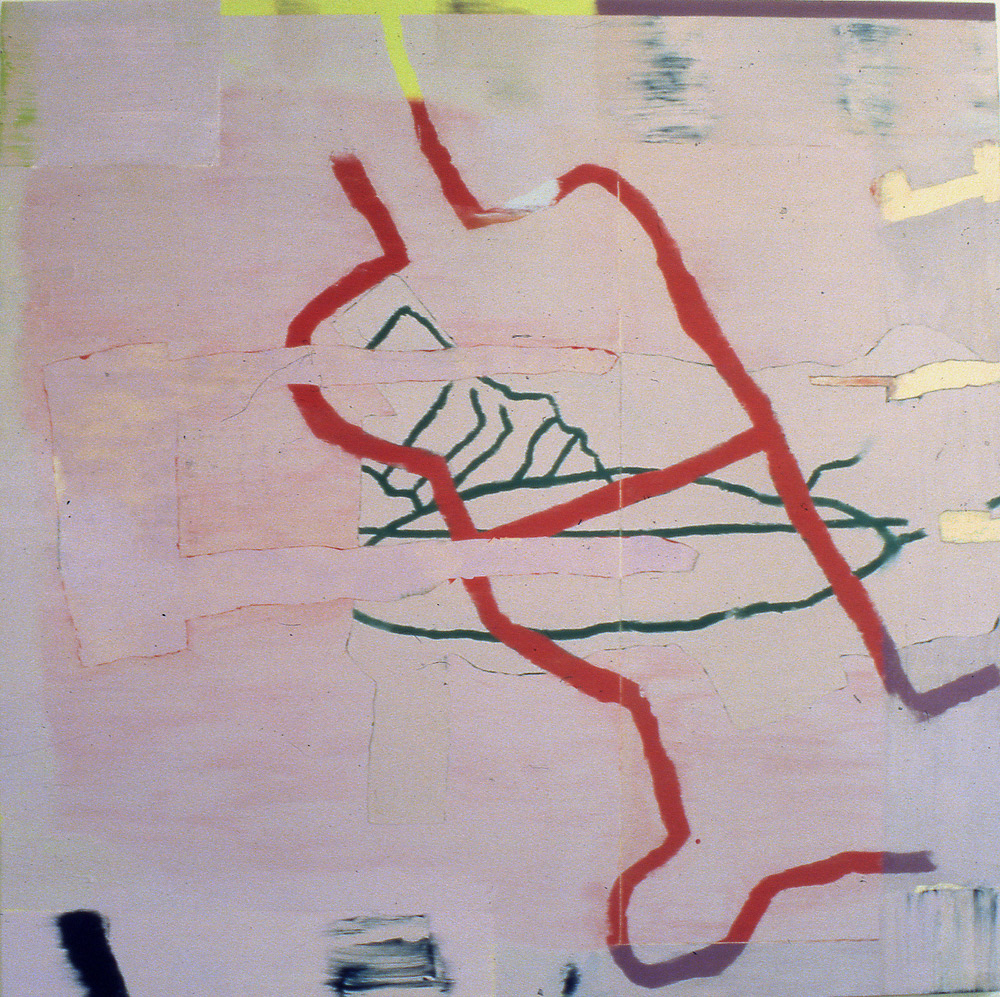
As time passes and my work evolves, I find that it reconnects more distinctly with some of the issues that preoccupied me during the 60s and 70s. I recognise links, particularly with some formal modernist concerns I had in much of my work from the early 1960s, which now only exists as colour slides.
In recent paintings the demand for economy and focus is more urgent; this is a response to working demands/interests that pull in different directions. To recognise this is to accept uncertainty as an essential condition of my work.
In 'TAG', the colour field conveys an ambiguous, indefinable sensation, which connects and is part of the interplay between abstraction, process, and fluid visual references. It is a painting where the decision to stop was made early, at a point when there was an energy, economy and tension between the colour sensation and configuration. Looking at the painting on the computer monitor, colour muted, 'wide-angle' distortion – the narrow top edge reveals an under-layer of yellow and violet leading to red, a trace of an underlying colour structure. Simultaneously a configuration and traces – these awkward conjunctions are part of the work's edge and imbalance - one key element a vertical narrow gap/line, a proportional division.
The painting has an underlying layering that contains references arising from drawings, direct notations of everyday occurrences and things. I'm constantly making rapid drawings on scraps of paper, anything to hand and together they form a record and a stock of images. The experience of the mundane object, how it enters consciousness – that pale violet plastic fork on the pavement, in the accumulated muck by the wall – the blackbird dead on the road, pounded by tyres, a flat heraldic trace. These images act as an accumulating series of 'memory triggers'. 'TAG' – the painting is in a continuum, in a series of new works, and work yet to be made.